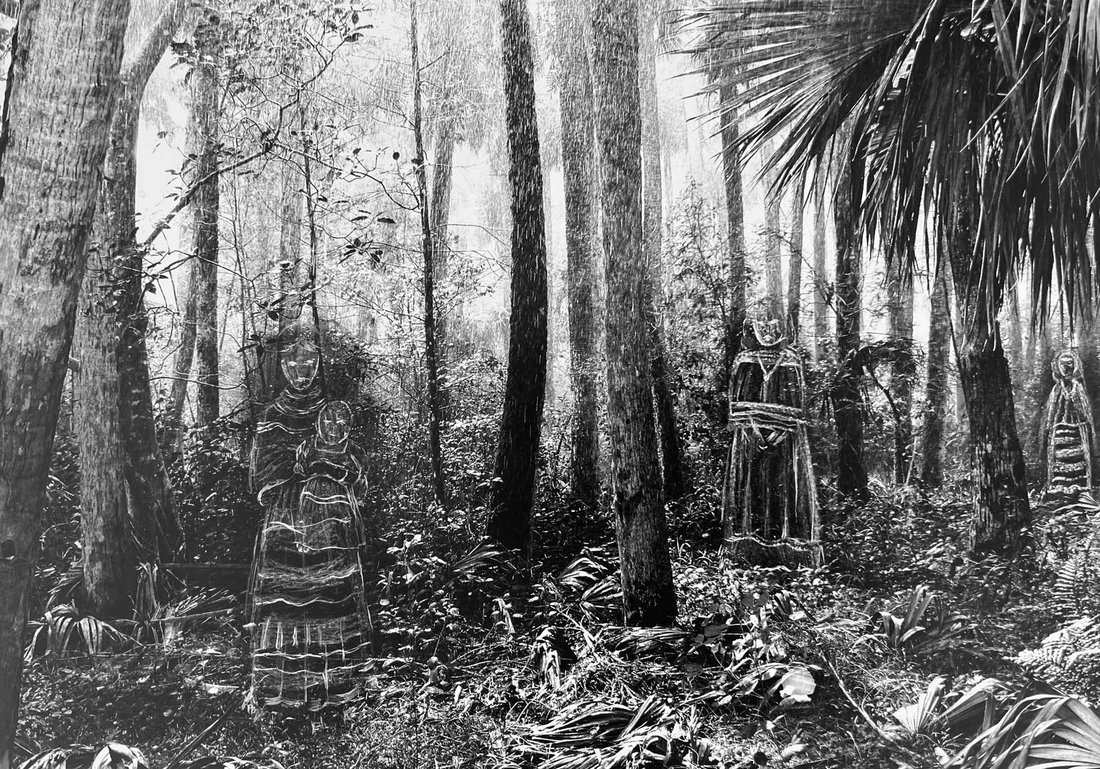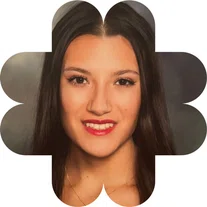

Ghosts of the Past

Height: 9.5" x Width: 13' | Material(s): DSLR camera, Photoshop, film negative, darkroom materials, silver gelatin paper, grease pencil | Process(es): Converted to neg. w Photoshop, print in darkroom, grease pencil to draw historic Seminole ghosts | Citation(s): https://www.britannica.com/topic/Seminole-people | Idea(s): Seminole people were pushed out during the Seminole wars. Figures represent ghosts of the past. | Curatorial Note: A haunting image reminding us of the spirit of the people that used to inhabit the spaces we’re familiar with. The work is provocative and thoughtful.
Olivia Wells


AP 2-D
The Benjamin School
Palm Beach Gardens, FL, USA
Student statement
Student statement
Please describe the context for how the idea for this artwork originated (was this part of your sustained investigation, an independent project, a class assignment, created during a summer study, etc.).
This artwork originated as a piece for my 2D Art and Design class and was a part of my sustained investigation.
In what ways did you practice and experiment when developing your sustained investigation?
In developing my sustained investigation, I experimented through the use of different materials and techniques. I would practice in a journal before attempting the idea.

In my investigation, I aim to explore how historical and cultural influences have shaped the state of Florida to be the way it is today. From the original native inhabitants, the Seminole people, to the more recent cultural influences such as those of Latin American countries like Cuba, Chile, or Puerto Rico, these influences have shaped the human experience and culture of the modern-day Floridian.
How did you demonstrate revision in your sustained investigation?
Revision was a key part of my sustained investigation. I would oftentimes redo projects or rework certain elements several times.
Your work was selected in part because it achieved synthesis. Can you explain your intentionality in choosing materials and developing processes to further your ideas?
The main components of this piece are the print and the drawings on top of it. Despite the photo having been taken with a digital camera, I wanted to incorporate traditional methods of photography by printing it in the darkroom. The drawings were done in white pencil to achieve a transparent effect and further the idea of ghosts.
How did your materials and process(es) choices shape the creation or meaning of your artwork(s)?
By printing my work in the darkroom, I was able to physically draw on the piece, which gave it a unique visual effect.
How did your art teacher support your artistic development?
My teacher was very supportive of my ideas for new projects. She would help me develop them by teaching me new techniques and providing me with constructive criticism.
Material(s): Process journal, pen, paper, pencil, printer, chalk paint, colored pencils, white grease pencil | Process(es): Historical research of Seminole people in Florida. Seminole wars pushed them out of their homeland. | Citation(s): https://www.britannica.com/topic/Seminole-people | Idea(s): Seminole people were pushed out during the Seminole wars. Figures represent ghosts of the past.
How did your school leadership (principal, assistant principal, guidance counselor, etc.) support your growth as an art student? This could be classroom visits, attending art shows, talking to you about your goals, etc.
All of the leadership at my school was highly supportive of the Art Department. They would attend art shows and visit classes to see what we were doing.
What is your advice to other AP Art and Design students?
My advice to other AP Art and Design students is to be experimental and take risks in creating art.
Melissa Grillo
The Benjamin School, Palm Beach Gardens, FL, USA
Teacher statement
Teacher statement
The AP Art and Design course supports inquiry-based personalized learning in the sustained investigation portfolio component. What strategies helped you guide students through inquiry?
The use of a sketchbook is the most vital piece guiding the student inquiry. Students in my class are required to complete a sketchbook assignment that incorporates research addressing the specific question of inquiry. Students are encouraged to begin this process without a fixed idea of the finished piece, allowing the piece to be informed by the process itself. A component of the research includes the opportunity for students to brainstorm the photographic technique that best communicates the idea. This encourages students to draw from their understanding and knowledge of photography to seamlessly unify the medium with the message.
How did you scaffold writing into the art-making and thinking processes?
Writing is a critical component throughout the course. I encourage students to continuously write in their sketchbooks in addition to collecting materials that inform their artistic process. The writing can be very informal and is not graded. During the class time provided for sketchbooks, I conference with each student independently to discuss ideas and possibilities for the artwork. This process is repeated multiple times throughout the year, which allows students to modify and grow with their portfolio.
How did you support skill development AND inquiry in the AP Art and Design curriculum?
Students are required to take two prerequisite courses prior to AP Art and Design at my school. During those two course, I stress the importance of craftsmanship and skill while creating work. These expectations continue into the AP course where students truly expand and refine their skill set as they use photography as a means of expression.
How did you structure practice, experimentation, and revision into your AP Art and Design curriculum?
The sketchbook plays a significant role in the practice and experimentation process as well. Students are required to document their process as they create the work. I encourage students to document what they perceive as "failures" as much as they document the "successes." By documenting this, students begin to recognize that all of the outcomes are part of a larger process. This takes away the misperception of the finality of failure and allows students to embrace the process as growth.
What creative programming (i.e., exhibit spaces, mentoring programs, curricular supports) have you implemented to support AP Art and Design students?
All of our AP students host a show in the spring. They curate the work, hang the show, and are responsible for advertising and inviting guests. Students are somewhat accustomed to teachers making decisions about many of these facets. This show gives them the opportunity to think of their work as a cohesive presentation. Students have been extremely creative with their presentation of pieces as well the selection of specific works.
What did you learn from working with your student?
I learned how impactful it is for students to find a part of the world that resonates with them as an individual. Using Florida's cultural history as a framework, Olivia created pieces addressing the indigenous population, her Hispanic heritage, and how cultural influences merge and meld to shape a place. Olivia combined her historical knowledge with her profound sense of empathy to explore the space we share with those who came before us, using that knowledge as a means of introspection and as a cultural statement. The piece features an image of a historical battleground, which is currently located in a state park. Olivia chose to create the image on film to represent the time period. She knew she wanted to include figures from the Seminole tribe in the image by drawing them onto the surface of her print, so she intentionally darkened spaces between the trees by using the technique of burning while printing in the darkroom. Illustrating the figures with a white gel pen unified them with the markings on the trees while allowing those figures to emerge from the landscape. The ghost-like translucency of the figures references the presence of the past in the present.
Olivia Wells
